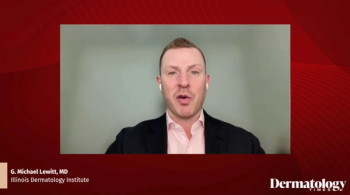
Diagnosing Vitiligo and Improving Care Provider Awareness
Expert perspectives on the diagnosis of vitiligo and considerations for improving provider awareness in dermatologist and community settings.
Episodes in this series

Transcript:
Seemal Desai, MD, FAAD: I’m glad, Bill, that you mentioned diagnosis because I think we’re delving right into that. If you don’t mind, I’d love to get your pearls on diagnostic steps. What do you do when you approach a patient with a different skin type, for example? Or testing, how do you talk to the patient? You’re in the examination room, give us some practical sound bites on what you like to do to work these people up.
William Damsky, MD, PhD: Thanks for the question. I think physical examination really remains the backbone of diagnosis in vitiligo. I think for the vast majority of patients, a careful physical examination by preferably a board-certified dermatologist, but certainly someone with experience in the area, is ideal. What we look for in vitiligo is complete pigment loss, what we call depigmentation. It’s an important distinction to make from hypopigmentation, which is the relative loss of skin color but not the complete loss of skin color. In vitiligo, in the vast majority of patients, we see depigmentation. If we see hypopigmentation, the differential diagnosis is a little different, so really making that distinction is important. A really handy tool that dermatologists commonly use to examine patients where vitiligo is a consideration is something called the Wood’s lamp examination. Wood’s lamp is basically a black light, and what it does is, it helps to accentuate areas of true depigmentation. If the skin has lost all of its melanin content, all of its normal pigment content, it becomes quite apparent under a Wood’s lamp examination. And that becomes particularly important to patients with lighter skin because oftentimes, vitiligo can be unapparent in patients with lighter skin. Oftentimes, under Wood’s lamp examination, we’ll identify vitiligo lesions the patient wasn’t even aware of. I think, really, especially early on, a Wood’s lamp is important, and you should expect your dermatologist to be taking that out to examine you.
Seemal Desai, MD, FAAD: I love the Wood’s lamp. I use it all day long. It’s my workhorse. It also, I think, to your point, gives the patient a sense that you’re actually looking and you’re taking the time to delve in instead of just saying, “Oh, that’s a white spot, it’s vitiligo.” We don’t want a patient with vitiligo to ever leave our offices thinking they have no hope. It’s upsetting sometimes to see patients feel that hopelessness because there is hope. There are things we can do to make it better. Most importantly, there are things that are on the horizon. Speaking of hope, though, that brings me to a question that you segued to well. What do you think is theawareness factor among primary care physicians or the medical community or even among dermatologists who don’t treat a lot of pigment diseases about vitiligo? Why do you think we’re starting to talk about it more, which of course, I am so happy about, but what are your thoughts?
William Damsky, MD, PhD: I think it’s really an exciting time in vitiligo. Of course, it’s potentially a devastating disease, and it is really difficult to have, but there is some light. I think that light comes from new research that’s helping us to understand disease pathogenesis at a better level, that research bearing out into pathogenesis-directed therapies, and those pathogenesis-directed therapies actually being incorporated into large controlled clinical trials where we can really evaluate efficacy. Although we still don’t have an FDA-approved repigmenting agent in vitiligo, I think it may be on the horizon. So there’s really a lot of excitement. In terms of awareness, I think this is a critical question, and I appreciate you asking it because I think that there is the recognition of vitiligo. Certainly, dermatologists know vitiligo and most know it well. Among primary care, although they may recognize vitiligo, I think the message is that it needs to be taken seriously and that it’s not a cosmetic disorder. As you explained so eloquently, it’s a medical disorder and it shouldn’t be dismissed in patients who want to be treated, which is probably the vast majority, and they should be referred to someone who can treat them. I think, really, it’s that message: take it seriously, listen to what the patient wants, and if the patient is interested in pursuing treatment, they should have that opportunity.
Seemal Desai, MD, FAAD: I think, to tie into that, one of the things that I share when I speak about vitiligo at meetings and conferences and platforms like this, the earlier we can treat the patient, the better. There are data to support the fact that the longer the depigmentation has persisted in that area of the skin, the less likely those melanocytes that are hiding in the bulge part of the hair follicle, which is where we think they repopulate from, are going to be there. That continued oxidative stress and that CD8 T-cell–mediated damage for persistent depigmented patches is a challenge. I think one of the messages is we need to educate like we’re doing today and like we’ve done in other sessions, that we want to see the patients sooner, faster, and treat them more aggressively so that repigmentation can happen faster, you can stabilize these patients better, and then maintain their outcomes. I think if you treat them earlier, you start to notice that repigmentation faster, and that itself leads to better compliance and adherence to treatment. Certainly, that’s a goal of therapy when I see my patients.
William Damsky, MD, PhD: If patients are getting better and the disease is being taken seriously and being treated aggressively if it’s appropriate, I think patients are more willing to be compliant with therapy. I think it’s so important.
Transcript edited for clarity.
Newsletter
Like what you’re reading? Subscribe to Dermatology Times for weekly updates on therapies, innovations, and real-world practice tips.






















